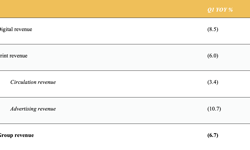Twitter has really been in the news lately. Even Gordon Brown got in on the act with his contribution to the transatlantic row over healthcare that erupted on the online social media website. It was also very busy around the time Michael Jackson popped his jewel-encrusted clogs – with thousands of MJ fans clogging the twitterverse with melancholy.
Basically, if anything happens now, it gets twittered. In fact, even if it doesn’t happen, it gets twittered. Some joker decided to post ‘RIP Rick Astley – we’ll miss you’ in response to the tide of Michael Jackson messages, which sparked a twitterstorm that forced Mr Astley’s people to issue a statement saying he was alive and well and on holiday in Thailand. Just as well, we were ‘never gonna give him up’ that easy.
The Guardian’s April Fool this year was twitter-related – “Guardian to go twitter only” was the headline, with reworked headlines from the archive such as (in 1927), “OMG first successful transatlantic air flight wow, pretty cool! Boring day otherwise *sigh*”.
And it’s not for kids - Nielsen NetRatings research says that adults use Twitter at twice the rate teenagers do. Only 16% of Twitter users are under 25, and only 6.6% of teens have a Twitter account.
So what with all the general furore around pressure on publishing businesses – local newspapers struggling with big print runs and dwindling advertising, Maxim recently canning its print edition to focus exclusively on being a website – anything that looks like a cheap internet-led strategy is going to capture the executive attention. So here we are, all trying to work out how the hell to make money out of Twitter.
Catch the wave
It certainly has caught some sort of zeitgeist wave – global Twitter users went through 44 million in June, adding 7 million in one month, and up from 2.9 million a year previously. But is it just the “new facebook”? Can any real use be made of it in a business context, and particularly by publishers?
Well, Sky News made really interesting use of it to cover the G20. Journalists at the protests tweeted what they saw from their mobiles. They also used the twitpic image tool to post pictures taken, again on their phones. Sky collected all the tweets and pictures into a single feed and hosted it on one of their news pages.
The result was a collage of 140 character news nuggets which managed to paint a really excellent picture of how the protests unfolded – I for one was riveted. It was a bit like watching one of those movies filmed from half a dozen different viewpoints.
The journalists, freed from having to talk on the phone, or to camera, just observed and wrote very short updates which were much more frequent than might have been the case with more traditional reporting. You also sense that the journalists were able to get much closer to the action like this than if accompanied by a camera crew or photographer, and carrying a load of equipment. The Guardian did much the same thing, and to much the same effect.
Journalists were also early adopters of Twitter as a tool for digging up stories – many use it for asking for information, or looking for more depth for a story they already have. Estates Gazette regularly appeals for information for its regional features, while Krishnan Guru-Murthy can be found asking for opinions just before he records Channel4 news. Indeed, he was ‘twinterviewed’ by journalism.co.uk about his use of Twitter.
Many magazines now have twitterfeeds on their websites, where the editor’s pithy musings are scraped from his twitterpage and dropped on the magazine’s homepage. And most people now have a twitterfeed that goes the other way. I’ve been running one for one of my own events for a few months, and now get almost as much traffic from my twitterfeed as I do from Google.
Read my story
This is all very ‘broadcast’ though – we, the anointed ones, the editors and journalists, choose what we are going to show to the masses, and don’t really interact with them. It strikes me that where Twitter could really help is in generating real interaction between editor and reader, or between one reader and another. NME magazine is a great example of a broadcast approach to Twitter – they post regularly enough – every couple of hours – but there’s no interaction between them and their community of 28,000 followers. A journalist whose identity I shall protect precedes each of his automated tweets with the command “Read my story”. He couldn’t make it less appealing if he did it in block caps, underlined, and with an exclamation mark at the end(!).
Given that Twitter is about interaction – it’s just like having a conversation in a crowded room where everyone can hear you, and butts in now and again – that we make so little use of this aspect is disappointing.
Learn from Al
Indeed, in researching this piece, I couldn’t find one magazine twitterfeed that appeared to correspond with its followers in the way that Alastair Campbell does. There he is, to some the personification of arrogance in politics, chatting away on Twitter with some of his 9,000 followers.
See, Twitter is about the conversation. So how can you get involved in one?
Well, I suspect the answer to that is relatively simple – how do you get involved in a conversation? You answer someone’s question, or you just walk up and say ‘hi’.
All the ‘official’ magazine twitterfeeds are automated – I know mine are – they pick up news from the website RSS feed, and dump it into the twittersphere. Probably most days no one actively logs in, as all the journalists have their own private identities on Twitter, with their own communities of followers, and that’s where they log in, to see if they’ve got any response to any of the fishing for stories they’ve been doing.
If no one logs in to the main feed, no one will check to see if anyone’s sent any messages to it. And so no one will reply to any of them. And pretty soon the people sending the messages will stop. As part of my research for this article, I sent messages to a reasonable number of ‘official’ publication accounts on Twitter and got just one response. Well done Construction News, shame on the rest of you. What if I'd been a subscriber trying to get in touch?
Can you afford the time?
So here’s the thing. To get any interaction, you have to do some work. Work takes time, and money. Someone has to log in to the main feed, have a few conversations, answer the questions they find, and generally clean house. And of course doing this will prompt more conversation – if your community see you interacting with anyone, they’ll be trying to get their own bit of interaction, so the time it takes to keep on top of it will grow and grow until pretty soon all your employees are fully employed on Twitter, and you forget to publish that week.
Given most publishers are digging down the back of the corporate sofa to find the cash to keep as many staff on as they can, this may not be the best time to be hiring a dozen people to run your revenue-free Twitter service, so maybe that’s one for the future – although Sky News now has a “Twitter Correspondent”, who seems to do just that.
Limit the interaction, milk the clicks
Can you encourage some lower level of interaction? Maybe you could ask specifically for one particular kind of contribution? Let’s go back to NME – could they prompt followers for live music reviews? “Saw U2 at Wembley. Great but not like 1983. *sniff*”. Contributions from the community would enliven the feed, give greater depth, and maybe even help with the process of spotting new talent. If it produced a level of interaction that was manageable, it would deepen links with readers, help journalists with stories, and protect the NME brand in this frightening digital age.
And can you make money? Well, until twitter-for-business turns up, you can only use it as an excellent and highly viral traffic referral tool. As I said, I get as many clicks from Twitter as I do from Google.
But you need to make sure the arrival experience is one that helps them spend money – do you have a ‘subscribe’ link on every page you link to from Twitter? Do you have page furniture which aims to communicate in a targeted way with people who drop by on the strength of a tweet? Remember, if you’ve been ‘retweeted’, then these visitors are coming at the recommendation of someone else – that’s a great moment to try to convert them to a paying subscriber.
Vox populi
I often think that Twitter is rather like the old Roman forum – a big public place where people would shout the odds, or have semi-private conversations. They’d hang out together chewing the fat and generally putting the world to rights. Anyone could walk by and join in the conversation, as long as they weren’t slaves of course. Subjects would range from politics and war to sport and sex, just as they might down your modern local. The Roman forum was the central gossip hub of the community.
People have always had a strong need to gossip – and it’s certainly still true today. Celebrity gossip mags are still massively popular, and just look at the stories still coming out of little Michael Jackson’s demise. Publishers have always been skilled at making money from gossip – think of Lloyd’s List – a venerable publishing institution born of a gossip sheet circulated around coffee houses that told people when ships were putting into port. If Lloyd’s List were launching today, it’d be done on Twitter, the 140 character format would be perfect.
So, really, Twitter is just a big old gossip machine. Making money out of Twitter should be just like making money out of gossip. Isn’t that what we all do anyway?










